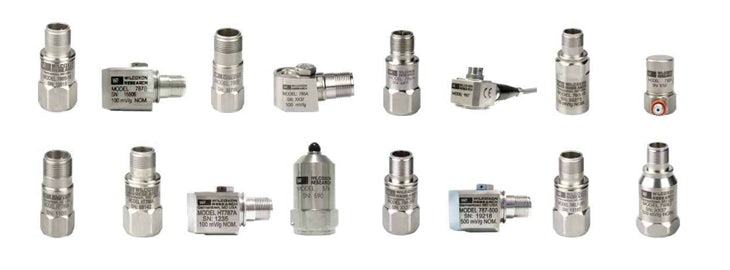For monitoring and overseeing rotating machines (pumps, motors, fans, gearboxes), you naturally want to use reliable and high-quality vibration monitoring systems. In this article, we discuss 11 key points to consider when choosing the right accelerometer for industrial applications.
#1 Acceleration Measurement Range
Most industrial applications use an 80g or 50g acceleration measurement range.
- 80g sensors offer a broader dynamic measurement range.
- 50g sensors may clip the signal, resulting in sensor overload if the vibration amplitude exceeds the measurement range. This clipping is referred to as “clipping” in English.
#2 Reliability of Measurement Signal Throughout Sensor Lifespan
- A sensor can be affected by many external factors, impacting its long-term accuracy:
- Piezoelectric stabilization of the PZT crystal minimizes signal drift over a long period (several years).
- Hermetic sealing (preferably verified by helium leak tests) protects internal components from external contamination and oxidation.
- Verify if the manufacturer provides reliability data, such as Mean Time Between Failure (MTBF), which indicates the average interval during which the sensor operates without failure.
#3 Sensitivity Tolerance
Industrial accelerometers typically have a sensitivity tolerance range of 5% to 20%. A tolerance band of 5% provides the highest accuracy and reproducibility, while a broader tolerance of 10-20% can be used when the exact sensitivity value can be programmed into the data acquisition equipment.
Tolerances are most important if your data collector or online system cannot effectively handle changing sensitivities for individual accelerometers. A measurement trend may show significant deviations when swapping sensors with a tolerance of 20%.
#4 Acceleration vs. Velocity
Acceleration and velocity sensors detect different types of machine faults:
- For most applications, velocity sensors are used because a velocity signal is generally the best indicator for monitoring the machine’s condition, suitable for both slow and fast rotating machines/components.
- The signal from accelerometers can be converted to velocity through integration when the appropriate sensitivity and quality are chosen.
- Acceleration measurement is more suitable for monitoring gear frequencies and early detection of bearing issues.
- The signal from accelerometers can be converted to velocity through integration, allowing both measurement types to be registered with one sensor.
- For both solutions, there are various options for the output signal: top or side exit, a range of sensitivities and tolerances, integral cabling, and certifications for hazardous areas.
#5 Certifications for Hazardous Areas
Vibration sensors are available with certifications for almost any type of hazardous area found in industrial environments (ATEX). When choosing the accelerometer, ensure it is suitable for the correct zone where it will be installed.
#6 Sensor Resonant Frequency
Measurement frequencies near the sensor’s resonant frequency can cause erroneous readings. The signal may clip, resulting in low-frequency ghost signals. The sensor’s resonant frequencies should be about twice as high as the highest expected measurement frequency.
#7 Temperature Range
Determine in advance what the temperature will be at the location where the accelerometer will be installed. The ambient temperature greatly influences which type of accelerometer is suitable for the application.
- Standard industrial accelerometers with built-in electronics are limited to 120°C.
- High-quality components allow some sensors to operate at temperatures up to 150°C.
- Piezoelectric accelerometers, which do not contain internal electronic circuits, typically operate up to 260°C.
- Special high-temperature sensor elements enable operation at temperatures up to 760°C, but these sensors also require other considerations, making it important to balance temperature requirements with factors such as cost and robustness.
#8 Cabling
There are many choices for accelerometer cabling, so it’s important to consider the following points:
- Ceramic/metal feedthroughs separate internal sensor components from the cable to keep all moisture and contamination out of the sensor.
- Testing sensors solely at the pressure level specified in the specifications may not detect a fracture. For underwater applications, sensors should also be tested at multiple pressure levels to detect problems.
- For deep underwater applications, a cable with insulation that prevents damage in the event of water ingress should be used.
#9 – Insulation and Housing
The design of the sensor and cables must protect the signal from environmental factors that can affect the data:
- It is necessary to use a shielded cable where the shielding continues to the junction box (not just to the sensor) to prevent ground loops and static charges.
- Sensors should be designed to withstand ESD (electrostatic discharge) up to 20,000 volts, but this specification is usually not listed on datasheets and must be requested from the manufacturer.
- Mounting pads can provide insulation (up to 1,500 volts) in environments where there are high voltage potential differences, high static charge buildup, or uncertain grounding conditions.
#10 – Measurement Range
100 mV/g sensors are most commonly used for monitoring industrial rotating equipment, but there are exceptions:
- 10 mV/g sensors for high-g-force applications, such as high-speed turbines or monitoring the second and third harmonics of gear frequencies.
- 500 mV/g sensors for low-frequency applications, such as monitoring wind turbine blades or slowly rotating machines in cooling towers.
#11 – Technical Support
Given the number of important considerations when choosing the accelerometer, technical support from the manufacturer and a competent sales team is crucial for selecting the right accelerometer for your application. Istec can guide you through the wide range of accelerometers and help you choose the right sensor for various industrial applications. Our specialists, with years of experience in vibration measurements and sensors, can also perform the installation or support you in this process.
Read also: 6 mounting methods for accelerometers

